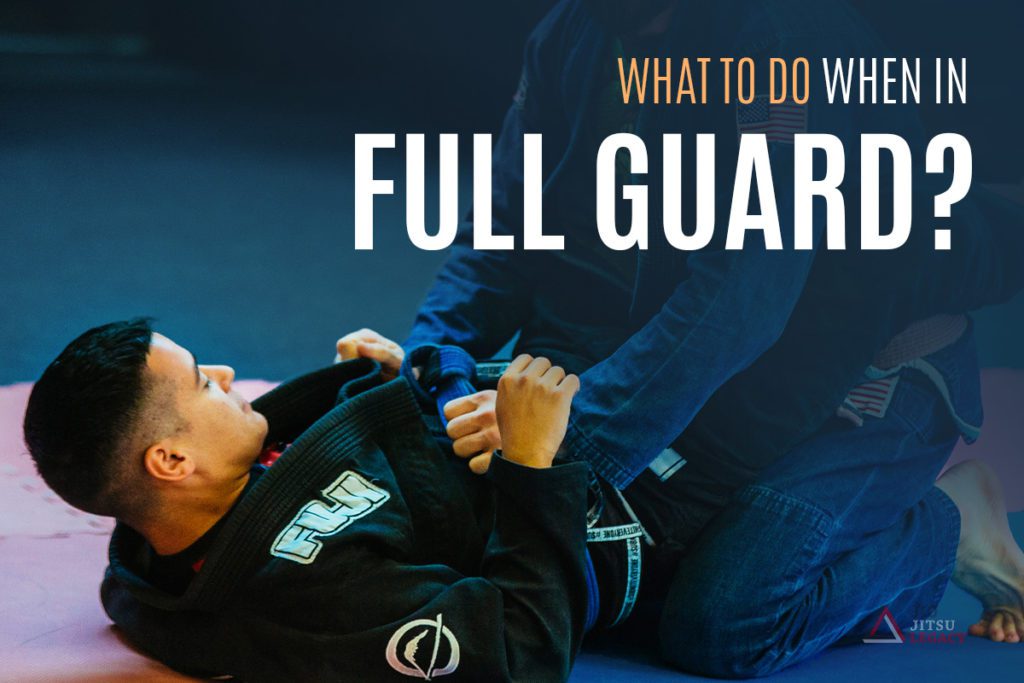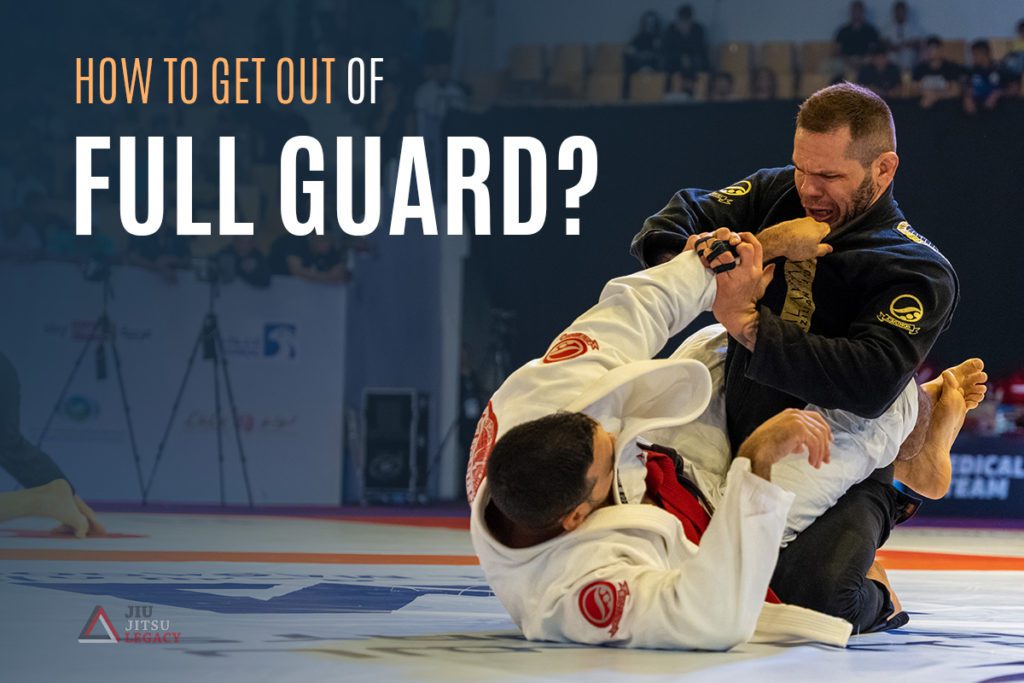The BJJ full guard is one of the toughest positions to crack. Why? Because with their guard closed tightly around your wait there is nothing you can do until you open their legs!
This article will cover well-established options for dealing with the closed guard in BJJ. But then I’ll move on to explore some moves that might seem to go against everything you’ve been taught about passing the guard, but which actually work!

The one position that was pure torture for me as a white belt was the BJJ full guard, or as it’s commonly called, the closed guard. I just couldn’t figure out a way to open it up and pass, no matter what I did. The agony continued even after I got my blue belt.
But, somewhere during my time spent at blue I had some realizations, which, in the following years, helped me get over my closed guard traumas and enjoy being caught in the BJJ full guard.
The main thing I understood was that the more I moved, the worse I made things for myself. The closed guard is like quicksand: struggle, and you will go down much faster. A big reason for that is the possibility of setting traps in all directions, essentially luring the top person to move into a submission or sweep by themselves.
It is like an Indiana Jones movie – you’re exploring a tomb filled with thousand-year-old traps and undead mummies armed with just a whip. So, just like Indie did it, so should you – first and foremost, don’t go running into the traps (for the most part).
Let me put things into perspective for you. As you may know from your experience playing closed guard from the bottom, sweeping or submitting someone is very hard if the top person is only trying to fend off your attacks. The moment they start to work on passing, they create an abundance of options which you can easily capitalize on.
So, now just flip the script and reverse the roles. You’re on top. You want to pass. However, you now understand that moving excessively will actually aid the bottom person in setting up their attacks. That is the ultimate trap to be aware of when you’re stuck in the BJJ full guard.
A Few Common Grip Fighting Misconceptions
“Break the griiiiiips!!!” is one of the things you most often hear at tournaments. The one thing coaches, especially old-school ones, say is you can’t allow the guard player to get a grip on you when you’re on top. Allow me to question conventional wisdom and ask, “Why?”
Any sentiment that begins with the word “always” or “never” is an absolute statement. I urge you to question absolutes – “always break the grips” or “never allow your opponent to have grips.” In this case, I’m here to say that you do not have to always break grips when you’re in someone’s closed guard. In fact, you should do it only in certain situations.
Since this is not a grip fighting article, I’ll just leave you with this: If you break the power of a grip, it does not matter if someone is attached to you.
Where does the power of a grip come from? The elbow. When somebody grabs your gi, they can only push or pull. To do either, they need to have their elbow close to their body.
So, instead of trying to break grips every time someone reaches for you from the BJJ full guard, focus instead on making them extend their arm. Now that their elbow has been separated from their body, the grip is weak and useless. Get your own elbows to your body, head over your butt, and you can start opening that pesky closed guard up.
How to Get Out of Full Guard

Getting out of the full guard is difficult because the guard player has the strongest parts of their body (their legs) around your waist, essentially rendering the strongest parts of your body useless. The solution is obvious: free up your legs in order to beat theirs. The conundrum is how do you free up your legs without falling into the traps we mentioned earlier?
Standing Up out of Full Guard
My personal favorite option for passing the guard during my blue and purple belt rolls always started with standing up. The issue with standing is that your opponent can pull you back as you’re standing up, they can stay attached to you, try to sweep, or set up Omoplatas/triangles.
Commonly, when people stand up in the guard, they finish still facing their opponents, with their legs slightly wider than hip-width. Sorry, but that won’t do the trick.
When passing standing, your aim is to get to your feet turned slightly sideways in relation to your opponent. Both your feet should be pointing in the same direction, to the side of your opponent. Keep your head over your butt and your elbows close and you’ll be able to strip their legs off with ease, while being completely safe from everything!
There are two ways to stand in the closed guard – the traditional way where you hold one of their sleeves, trapping their arm on their belly, so that you can place the foot of that leg up first. Next, pivot the other leg on your knee, widening your stance, and stand up straight upwards, avoiding tilting to the front. Remember to end up at an angle to your opponent, with your feet and knees parallel to one another.
The second version of standing up is easier – post your hands on the opponent’s hips, press hard, and jump up with both legs. As you straighten your spine, turn to the side. Stripping off their legs is easy at this point, and most experienced people will already be transitioning to an open guard as they realize the closed guard has been lost.
Going Forward to get out of Full Guard
The Tozi and Sao Paolo passes are an extremely cool pressure passing option to deal with the full guard. The only difference between the two is in the grips.
For the Tozi, you go in with an underhook on one of your opponent’s arms, as you’re going forward, lying on their chest. Your other arm blocks the free arm on the same side. Your goal is to go forward and then move sideways, causing the person in full guard to end up at an angle in relation to your hips.
Once there, you can start circling around with your legs (like a clock) ending up with a smashed opponent. A palm to palm grip will finish the job, given that you still have underhook control over the far side shoulder.
The São Paulo has a sneaky grip on that free arm from the get-go. Instead of an underhook, the goal is to pass an opponent’s arm behind their back to the other side, so that you have it trapped between them and the ground. You then proceed to do the same as before, keeping a hold of the trapped arm.
Stacking through the Closed Guard
I did not believe this would work until I gave it a try. Now I swear by it. The hardest part is learning how not to over-commit, but rather place a full guard player under pressure. The trick is to place your palms on their biceps, but try not to push, rather just holding their upper arm in place, preventing them from touching their elbows to their ribs.
You need to lift your entire body off the ground, with just your toes touching the mats. The goal is to put chest pressure on the opponent, similar to how you would do it from topside control. Remember not to lift the butt up in the air and extend the knees, but rather keep your knees hovering just a couple of inches off the mats.
After you pressure the opponent for a while, making them wonder what is happening, you’ll begin to move to the side. Your aim is to look for a stack position, which will require you to get them onto their shoulders. Place a leg behind their butt to help you stack them further. Once you get them on their shoulders and are angled to the side, use both arms to hug their far side shoulder.
That leg that was behind their butt will now go against their hip. Use it to push their hips away from you, popping their legs open.
If that was as clear as mud, well have I got the 41 minute long explainer video for you! This video, while lengthy, is a great start on your journey to stacking through the closed guard. If you don’t have time to watch it now, save it to your “Watch Later” queue and check it out on a day where you can’t train but still want to get some mental reps in!
The Game Over Cheat Code
This option is not for those that believe playing by IBJJF rules. For everyone else, though, it is an amazing option to deal with the full guard.
First, grab your opponent’s wrist or gi sleeve on one side. Once you have it, sit back on your butt, placing a foot in the biceps of the arm you’re controlling with the grip. Extend the leg and you can rest, as they have no way of coming up on top of you.
From there, you can basically pick and choose how you proceed. My preferred option is to put both legs over their hips, lay back to pop open the full guard, and proceed to the Game Over Ashi Garami position which is highly illegal and very knee-reapy. You can guess how this ends for the guard player.
Desperately Creative Last-Ditch Options
I am not the biggest fan of giving your opponents attacking options, but just like Indiana Jones, sometimes you have to activate a trap in order to escape the tomb.
As long as you’re very confident of your abilities to defend a specific attack, then why not let the bottom person have it, so they open their guard for you? As long as your defense is on point, you’ll pass after a while.
Wim Deputter calls this approach the King’s Gambit – he lets the bottom person have a triangle so that he can pass. Not for everyone, but he manages to pull it off in competitions, so there is a method to his madness.
Note: This is another lengthy video, but Wim, like Priit in the video above, provides some serious knowledge:
In Conclusion
The full guard is difficult to escape because the guard player has many options available, while you can’t do much because moving exposes you to risk. Be aware of the traps and avoid moving needlessly to stay safe. To pass, you can choose to go in a specific direction (up, forward, stack, sit back, or Gambit) or even combine several of the options you have to pop the legs open and get out. Once you’ve opened the close guard, we recommend moving into one of the five dominant passing positions, so you can secure the pass.

Ogi is a black belt that does Jiu Jitsu full time and is very passionate about anything grappling-related.
He is also the head coach of Enso Jiu Jitsu in Macedonia and an aspiring Globetrotter.
